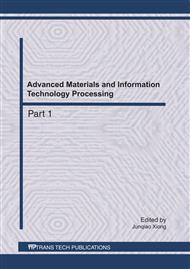[1]
Liveira A. Telling Stories About System Use: Capturing Collective Tacit Knowledge for System Maintenance[C]. Boston: Proceedings of the International Conference on Software Engineering and Knowledge Engineering, 2007, 337–342.
Google Scholar
[2]
Sutcliffe A. The domain theory for requirement engineering[J]. IEEE Trans on Soft Eng, 1998, 24(3): 174-195.
Google Scholar
[3]
Maiden N. Requirements Critiquing Using Domain Abstractions[C]. Los Alamitos, CA: IEEE Computer Society Press, 1994, 184-193.
Google Scholar
[4]
Lano R. Structured Approach for Pperational Concept Formulation[C]. Los Alamitos CA: IEEE Computer Society Press, 1990, 48-57.
Google Scholar
[5]
Zhi Jin, Ruqian Lu. Automatically multi-paradigm requirements modeling and analyzing: An ontology-based approach[J]. Science in China 2003, 33(4): 297-312 (in chinese).
DOI: 10.1360/02yf0093
Google Scholar
[6]
Howes N. On Using the Users Manual as the Requirements Specification[C]. Los Alamitos CA: IEEE Computer Society Press, 1990, 164-169.
Google Scholar
[7]
Kans M. An approach for determining the requirements of computerized maintenance management systems[J]. Computers in Industry , 2008, 59(3): 32–40.
DOI: 10.1016/j.compind.2007.06.003
Google Scholar
[8]
Hull E, Jackson K, Dick J. Requirements Engineering[M]. Springer, (2005).
Google Scholar
[9]
Nilsson V, Fagerstro B. Managing stakeholder requirements in a product modelling system[J]. Computers in Industry, 2006, 57(2): 167–177.
DOI: 10.1016/j.compind.2005.06.003
Google Scholar
[10]
Shen H, Wall B, Zaremba M , et al. Integration of business modeling methods for enterprise information system analysis and user requirements gathering[J]. Computers in Industry, 2004, 54(4): 307–323.
DOI: 10.1016/j.compind.2003.07.009
Google Scholar
[11]
Sommerville I. Software Engineering[M], Boston: Addison-Wesley, (2006).
Google Scholar
[12]
Glinz M. Statecharts for Requirements Specification—as Simple as Possible, as Rich as Needed[C]. Orlando: Proceedings of the ICSE Workshop on Scenarios and State Machines Models, Algorithms, and Tools, (2002).
Google Scholar
[13]
Anton A, Potts C. A representational framework for scenarios of system use[J]. Requirements Engineering Journal, 1998(3): 219–241.
Google Scholar
[14]
Breitman K, Leite J, Berry D. Supporting scenario evolution[J]. Requirements Engineering, 2005(10): 112–131.
DOI: 10.1007/s00766-004-0199-z
Google Scholar
[15]
Machado R, Borges M, Guerlain S, Gomes J. An Observation Model for the Collaborative Analysis of Real Workplaces[C]. Melbourne Australia: Proceedings of the International Conference on Computer Supported Cooperative Work in Design, 2007: 292–297.
DOI: 10.1109/cscwd.2007.4281450
Google Scholar
[16]
Nuseibeh B, Easterbrook S. Requirements Engineering: aA Roadmap[C]. Limerick Ireland: Proceedings of the Conference on the Future of Software Engineering, 2000: 35-46.
DOI: 10.1145/336512.336523
Google Scholar
[17]
Antunes P, Ramirez J, Respicio A. Addressing the conflicting dimension of groupware: a case study in software requirements validation[J]. Computing and Informatics, 2006, 25(5): 523–546.
Google Scholar


